Discovering Saltburn Pier - the first and last on the NE coast
The seaside piers around the coast of Britain stand as a powerful reminder of the achievements of Victorian engineers and entrepreneurs. There are currently less than 54 pleasure piers in existence around the UK coastline. Saltburn's Victorian pier was the first iron pier to be built on the North East Coast, is the most northerly surviving British Pier and the only remaining pleasure pier on the North East coast. Built in an exposed position and facing due north into the cruel and unforgiving North Sea, the history of Saltburn Pier tells a tale of survival against the elements. The pier was commissioned by the Saltburn Pier Company in 1867, designed by Mr John Anderson and completed two years later. The original opening of the pier was thought to have been in May 1869 but recent research has shown that the pier was not completed until some time in July that year.

Taking a walk over the water... Saltburn's Victorian pleasure pier.
As a railway contractor John Anderson was associated with the Stockton and Darlington and the South Durham and Lancashire Union Railways and was one of the first to become involved in the emerging ironstone industry in 1848. In Saltburn he saw the opportunity of making an investment and became one of the principal developers of the land put on the market by the Saltburn Improvement Company being one of the first to buy plots of land in Milton and Amber Streets. His most important acquisition was the site on Brittania Terrace/Marine Drive - both now Marine Parade - where he erected the 'Alexandria Hotel', the second most important hotel in the town. In January 1867 he was appointed resident engineer of the Saltburn Improvement Company and in the same year he formed the Saltburn Pier Company, for which he was both engineer and contractor.
The Pier Company promoters, including John Bell, Edmund Grove and James Taylor immediately petitioned the Board of Trade for permission to construct the pier at Saltburn and special permission was granted by Parliament via "The Saltburn-by-the-Sea Pier Order".

In December 1867 Chochrane and Grove of Ormesby delivered the first consignment of ironwork. Although the Board of Trade did not grant a provisional order for the construction of the pier until 6th April 1868 and the land and foreshore for the pier were not conveyed to the company until 3rd July 1868, The Yorkshire Herald reported on 21st December 1867 that the provisionary directors of the Pier Company hoped to start to pile on New Years Day, 1868. On the 31st January 1868 The Newcastle Weekly Courant stated that the first pile was driven on the previous Monday - January 27, 1868.
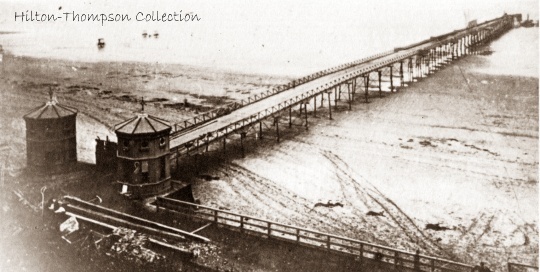
It was originally thought that the pier was opened to the public in May 1869 but more recent research has shown this to be incorrect. On Monday 3 May an article in the Newcastle Daily Chronicle stated that there were ten more yards of the pier to be added to it's length. On July 5 the same newspaper reported that the pier was 'so near completion that steamboats can land their passengers'. On the 14 July the Pier Company were advertising for two registering turnstiles. By the end of July it is clear that the pier was open and attracting many visitors. To ease the access to the pier and promenade from the town, work had begun on a 120 foot high wooden vertical hoist, also designed by John Anderson. Although reports claimed that the hoist was being 'rapidly proceeded with' and it was expected to open soon after the completion of the pier it did not come into operation until the following year.
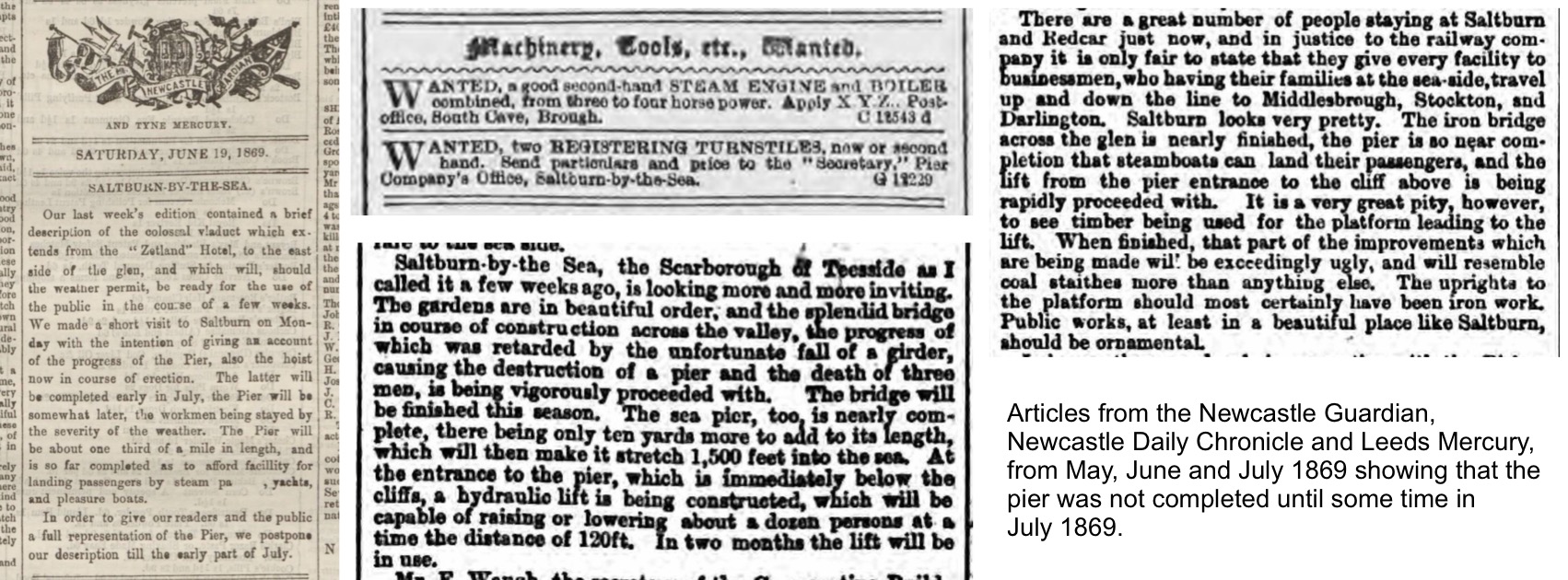
The pier proved to be an immediate success with over 50,000 visitors paying to stroll upon it during its first six months.
Consisting of iron trestles under a wooden deck, the pier was built to a length of 1500ft. There was a steamer landing stage at the head of the pier and two circular kiosks at the entrance. On May 14th 1870 two steamers operated a service from the pier to Middlesbrough whilst a band performed on the pier head. In the following month there were further steamer trips to both Middlesbrough and Hartlepool and an excursion to Scarborough aboard the Victor. The company also gained revenue from advertising spaces on the pier for 5s per annum. This early success enabled the Pier Company to announce profitable dividends for its shareholders and by October 1873 it was announced that all the shares had been disposed of.
During 1873 it was decided to build a saloon at the pier head - as had been originally intended - and to provide gas lighting along the length of the pier. 1874 also proved to be reasonably successful and at Whitsun 1875 it was reported that 'the whole stretch of the 1,500ft promenade appeared to be literally alive all day'
Unfortunately the first of numerous disasters struck the pier during the night of 21/22 October 1875 when horrific gales struck and 300ft of the sea end of the pier was washed away taking out the pier head, the landing stage and part of the pier deck.
The damage was repaired but, at a time when development of the town had halted due to a slump in the iron trade, the company decided that the lost section of the pier along with the landing stage - which had rarely been used - was not to be rebuilt. The subsequent alterations reduced the length of the pier to 1250ft. The pier re-opened in 1877 but the heavy debt incurred by the Pier Company led it to be wound up in December 1879. The Pier and hoist were sold at auction at the Alexandra Hotel for £800 in 1880.
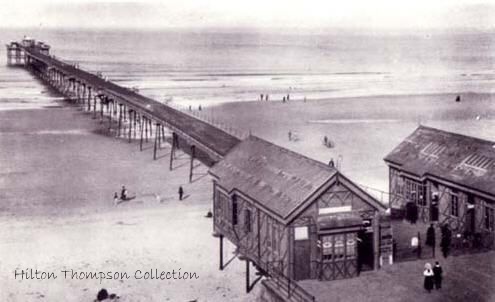
The new owners were the Saltburn Improvement Company who themselves had been acquired by the Owners of the Middlesbrough Estates following the formation of the Local Board in 1880 to administer the town. The new owners carried out a number of improvements to the pier in 1884. The pier head was widened and windshields, a bandstand, and refreshment rooms were added. The entrance kiosks were replaced by two larger buildings designed to match the style of the entrance to the new incline tramway which was built to replace the hoist. One kiosk was used as a cafe and the other as ladies and gentlemen's cloakrooms.
On 20th July 1887 the gas lighting was replaced and the pier was illuminated for the first time by electric lighting. Saltburn blossomed into a popular resort during the later Victorian, early Edwardian period. The pier itself provided genteel band concerts during the summer months and bracing promenading over the water.
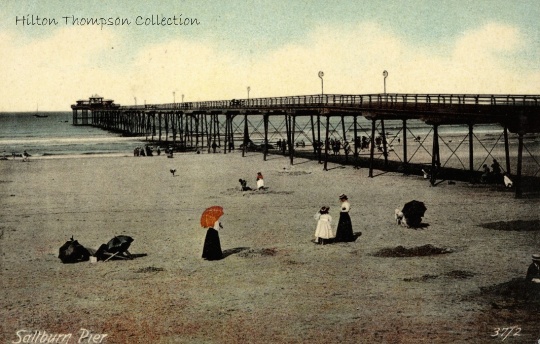
The pier-head suffered further storm damage in 1900 but escaped relatively unharmed for the next twenty years until May 1924 the china clay vessel 'Ovenbeg' (formerley the Russian registered St Nicholi) collided with the west side of the pier causing a great deal of damage leaving a gap of 210ft. A barrier was erected at the end of the shortened pier which enabled the remainder of the structure to still be used for promenading. The bandstand was, however, now inaccessible. On 30th March 1929 it was announced that the gap was to be repaired and a theatre was built at the shore entrance for dancing, concert shows and meetings. The damage caused by the collision was finally repaired, five years later, in 1930 and the full length of the pier was re-opened.
Purchased by the local council in 1938, Saltburn Pier, along with others like it, was sectioned in 1940 for fear of German invasion. By the end of the war the pier was in a very poor condition. A planning application to repair the pier was granted on 13 April 1949 but, due to the shortage of steel, restoration and repair work was not commenced until 1951 and the pier was finally re-opened to the public in April 1952 (the official opening took place on 31st May 1952) with over 25,000 visitors using it during the first month.
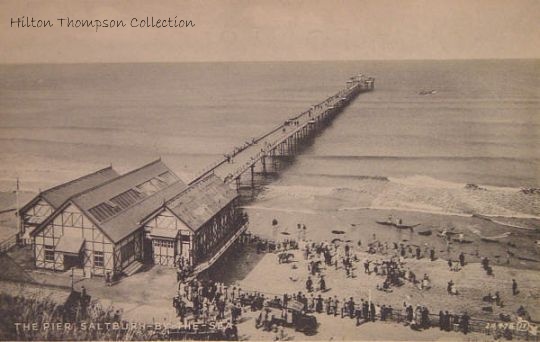
Severe gales hit again the following year and badly twisted the whole structure resulting in repairs estimated at £23,000. These took a further five years to complete, but no sooner had the pier reopened than two piles were lost at the seaward end costing a further £6,000 to replace. In 1961 another twenty piles were badly twisted in exceptional storms. Despite these problems the pier remained a popular attraction throughout the sixties with up to 90,000 people using it.
The 1970s were no kinder in Saltburn Pier's history. In 1971, 1973 and 1974 piles were lost at the seaward end leaving the pier in a dangerous state. As emergency plans were being drawn up to save the pier, a severe gale on 29th October 1974 washed away the pier-head, badly damaged the remainder of the deck and reduced the length of the pier to 1,100ft. Finally, in 1975, the local council submitted an application to the Department of the Environment to have the pier demolished.
Saltburn Pier continued it's fight for survival when a public enquiry concluded that only the last thirteen trestles should be removed and the remainder of the structure should be restored. The pier, now reduced in length to 681ft (206m), was completely refurbished, reopening to the public on 29th June 1978 after a closure of five years. The following year the buildings at the pier entrance were restored. The 1950's cladding was removed and new cladding designed to reflect the Victorian/Edwardian character of the pier was introduced.
Further restoration work was carried in the early 1990s when the entrance-building roof was renewed. With the new millenium and the aid of National Lottery Grant funding Saltburn pier underwent a major restoration programme designed to return it to its former glory. The grant enabled the cast iron trestles that support the pier to be conserved to reinforce the structure and the steel deck beams were replaced with traditional hardwood timber to reflect the pier's original appearance. Access to the pier was improved through the use of an inclined path that provides step-free access. It was officially re-opened to the public on 13th July 2001. The success of the pier restoration has been widely acknowledged, and the pier, along with the town's cliff lift, won a top placing in the Queen's Golden Jubilee Heritage Awards.
Pier of the Year 2009
In 2009 Saltburn Pier won the National Pier Society's Pier of the Year award. Many articles have since appeared in both local and national newspapers. The article in this pamphlet, written by Sophie Campbell, appeared in the Telegraph, published 21st August 2009
Research by Rebecca Hilton. Collecting primary source materials, articles and extracts from books related to the development of both Saltburn's and trying to validate them has offered conflicting information, much of which is often difficult to validate as many sources can prove to be unreliable e.g. newspapers or census data. Every effort has been made to ensure that the information on the history of the town presented here is as accurate as possible.

